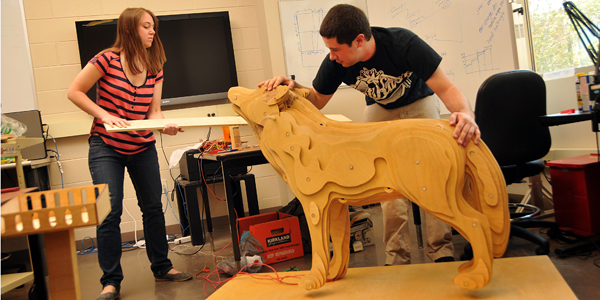Hunt Is Home to Animatronic Wolf

Let’s get this part out of the way from the beginning: the new student-built animatronic wolf unveiled on Friday does not actually howl.
It’s in a library, for goodness sake, where only the bleeps and blurps of new technology and the mechanical noises of the revolutionary bookBot are allowed.
But visitors to NC State’s shiny new Hunt Library can make the 4-foot-tall, 120-pound wooden creature appear to howl with a joystick mounted next to the now-permanent display in the glass-enclosed Apple Technology Showcase on the second floor.

He’s called “The Timber-Wolf,” because he’s made out of sheets of waterjet-cut Baltic birch plywood. And because that sounds a lot better than the bluesy “Non-Howlin’ Wolf.” He has a Facebook page and everything.
Built by mechanical and aerospace engineering students Michelle Phillips and Kevin Young as a capstone project for the University Honors Program, the wolf was made from a scan of a $3 plastic toy bought at Toys-R-Us. They checked out a 3-D scanner from the library, obtained a student license for GeoMagic computer-aided design software from 3D Systems in Morrisville and imported their scan into SolidWorks, another design program that helped bring the wolf sculpture to life.
With Park enrichment and undergraduate research grants, they bought the materials they needed and sought help from electrical engineering students and mechanical engineering professor Larry Silverberg, their mentor on the project. Since September, the two students — who first met while living on the second floor of the honors program dormitory as freshmen — have spent most of their spare time working on this lone wolf.
On to Universal
And the project is not just for show. Both Phillips and Young are interested in pursuing careers in mechatronics, a melding of mechanics and electronics. Phillips has long had an interest in theme park rides, which led to an internship last summer at Orlando’s Universal Studios, where she helped create some of the animatronic features in the new $400 million Diagon Alley expansion of the Wizarding World of Harry Potter. The native of Advance, N.C., begins a job at the Florida theme park on July 7.

“When I was kind of looking at what I wanted to do, I thought being a ride engineer would be the coolest thing ever,” said Phillips, who began her student career in biomedicine. “I changed majors when I was a sophomore and began to look at other options. I got involved in the Disney ImagiNations competitions here, and that led to the internship at Universal and now a fulltime job.”
Young, a native of Apex, N.C., starts graduate school in the fall, pursuing a master’s degree in mechanical and aerospace engineering with a focus on mechatronics. So he’ll be around campus to see how other honors students, engineers and visitors to the Hunt Library observe the interactive statue.
“We kind of want it to serve as an inspiration to others, to be creative in what they create,” Young said. “Most engineers just use an upgraded version of their senior design project as their capstone project. We wanted to go above and beyond that.”
The working wolf has a control panel with a show mode and an individual mode, so visitors can see the wolf open its mouth and wiggle its ears. It was supposed to throw its head back when it howled, but the weight of the wood and the friction involved was too big an obstacle to overcome in the short amount of time they worked on the project.
Not the First Mechanical Wolf
Still, it came off much better than the first student initiative to build an electronic wolf. Back in 1946, junior mechanical engineering student Ira Helms and his friends built a “mechanical wolf-man,” in an effort to save the school’s nickname, which the chancellor at the time wanted to change. They wanted to build a fully working mechanical wolf, but didn’t have quite enough time; instead, they made a boxy papier-mache head with a copper-framed body and spray painted it silver white.

They unveiled their faux-Frankenstein-Meets-the-Wolfpack creation at a football game against Wake Forest, with Helms inside and another student following behind with a control box with knobs and antennae. But Helms was overcome by the fumes from the wet paint and had to be rescued from his own monster. He modified it some and was able to take it to NC State’s first bowl game, the 1947 Gator Bowl, but the components did not survive the train ride home.
Phillips and Young are convinced their less ambitious, but more mechanically sound creation will last much longer – as long as no one climbs on top and tries to ride it. They were thrilled with the outcome, as were the dozens of students who showed up Friday morning for the unveiling.
For Silverberg, seeing the wolf in action was particularly fulfilling since he was originally skeptical that a pair of undergraduates could build a working device.
“I told Michelle not to do it three times,” he said. “But that just served as a motivation for them both. She doesn’t like to hear the word ‘No.’
“They achieved the goal they set out to do.”
And the final result is certainly a success, if not a howling one.
- Categories:


